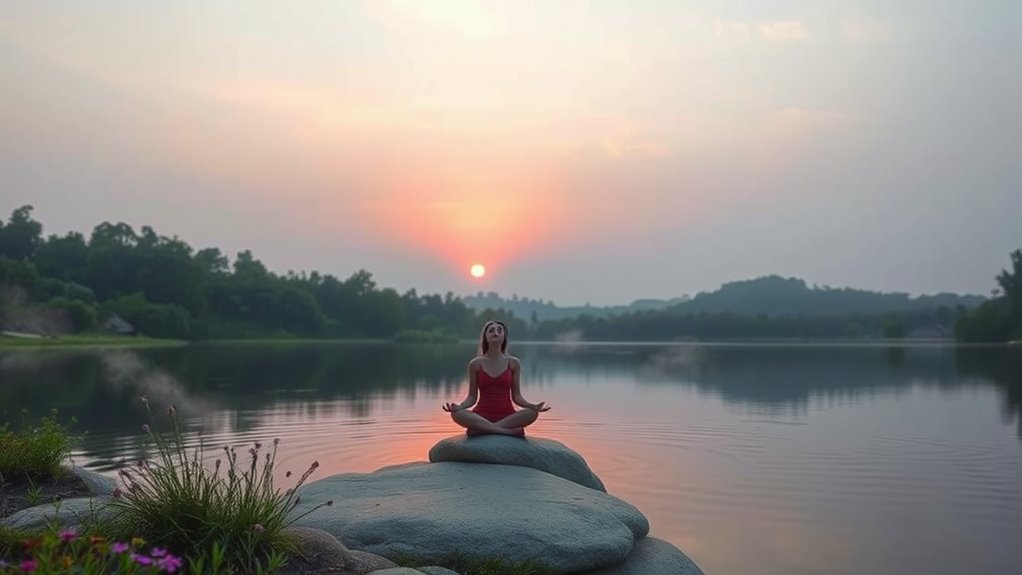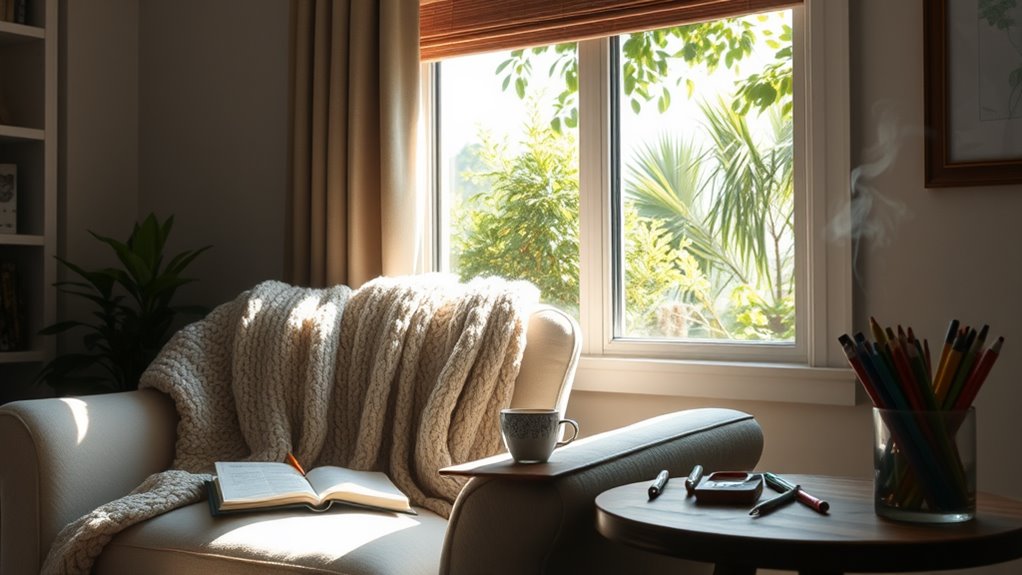Relaxation Techniques for Instant Stress Relief and Calm!
When stress hits, you can find instant relief with a few simple techniques. Try deep breathing exercises; inhaling deeply through your nose and exhaling slowly through your mouth can help calm your body and mind. Progressive muscle relaxation is also effective; tense and relax your muscle groups for a full-body release. Guided imagery can transport you to a peaceful place while gentle stretching or yoga helps to melt away tension. Don’t forget the power of uplifting aromas, like lavender, to create a soothing atmosphere. There’s so much more to discover about nurturing your calm and well-being!
Key Takeaways
- Practice deep breathing exercises by inhaling through the nose, allowing the abdomen to rise, and exhaling slowly through the mouth for immediate calm.
- Engage in progressive muscle relaxation by tensing and relaxing muscle groups systematically for effective stress relief and body awareness.
- Use guided imagery techniques by visualizing serene nature scenes to escape daily pressures and promote relaxation.
- Incorporate gentle stretching or yoga, focusing on breath and slow movements to enhance mindfulness and release tension.
- Utilize positive affirmations like “I am calm and in control” to reshape your mindset and foster relaxation.
Deep Breathing Exercises
Many people underestimate the power of deep breathing exercises when it comes to relieving stress. You might think it’s just about taking a breath, but there’s much more to it. By practicing diaphragmatic breathing, you engage your diaphragm fully, allowing your lungs to expand and take in more oxygen. This technique not only promotes relaxation but also helps lower your heart rate and blood pressure, creating a sense of calm.
To master this, start by finding a comfortable position. Inhale deeply through your nose, allowing your abdomen to rise as you fill your lungs. Then, exhale slowly through your mouth.
To enhance your focus, try breath counting. Count each breath: inhale for four counts, hold for four, and exhale for six. This simple practice trains your mind to stay present, reducing racing thoughts that often accompany stress.
As you incorporate these techniques into your daily routine, you’ll notice your ability to manage stress improves considerably. Remember, consistency is key—so make deep breathing a habit.
With time and practice, you’ll not only find immediate relief but also cultivate a greater sense of mastery over your emotions.
Progressive Muscle Relaxation
Ever wondered how simply tensing and relaxing your muscles could lead to profound stress relief? Progressive Muscle Relaxation (PMR) focuses on this powerful technique, helping you manage muscle tension and trigger your body’s relaxation response.
By systematically tensing each muscle group, you’ll become more aware of the sensations of tightness and relaxation, allowing you to release built-up stress.
Start by finding a comfortable position, either sitting or lying down. Begin with your feet—tense the muscles for a few seconds, then release. Notice the difference. Gradually work your way up through your legs, abdomen, arms, and face.
As you progress, you’ll not only relieve physical tension but also cultivate a deeper connection with your body.
Practice PMR daily, and you’ll soon master this effective technique. It’s a skill that, once honed, can help you quickly combat stress in any situation.
Guided Imagery Techniques
Guided imagery techniques can be a powerful tool for managing stress and promoting relaxation. By visualizing serene nature scenes or repeating positive affirmations, you can create a mental sanctuary that helps you escape daily pressures.
Let’s explore how these techniques can enhance your overall well-being and bring a sense of peace to your life.
Visualization for Relaxation
When life gets overwhelming, finding a moment of peace can feel impossible, but visualization techniques can be a powerful tool for relaxation. By harnessing mental imagery and creative visualization, you can transport yourself to a serene place, easing stress and inviting calmness into your life.
Here’s a simple guide to get you started:
| Step | Description |
|---|---|
| Choose a Scene | Select a place that brings you joy—like a beach, forest, or cozy room. |
| Engage Your Senses | Close your eyes and vividly imagine the sounds, smells, and sensations of that place. Feel the warmth of the sun or the cool breeze. |
| Focus on Breathing | As you visualize, take deep breaths. Inhale slowly, hold, and exhale, syncing your breath with the peaceful imagery. |
Practicing these steps regularly can enhance your ability to relax on command. Remember, the more you engage your senses and emotions, the more effective your visualization will be. With dedication, you can master this technique and reclaim your sense of calm, even in the midst of chaos.
Nature Scenes Imagery
Sometimes, taking a moment to immerse yourself in nature through imagery can transform your state of mind. Imagine yourself in a serene forest, surrounded by towering trees and the gentle rustle of leaves. By tapping into this nature scenes imagery, you engage your senses and create a sanctuary within your mind, encouraging relaxation and calm.
To enhance this experience, introduce nature soundscapes into your practice. Picture the soothing sound of a flowing river or the distant call of birds. These auditory elements not only ground you in your visualization but also elevate your emotional state, making the experience more vivid and impactful.
As you explore these scenic landscapes, allow yourself to feel the textures of the earth beneath your feet, the warmth of sunlight filtering through branches, and the fresh scent of pine.
This deeper sensory engagement empowers you to master your relaxation techniques.
Positive Affirmations Technique
Positive affirmations can be a powerful tool for reshaping your mindset and fostering relaxation. When you incorporate self-empowerment phrases into your daily affirmation practices, you’re taking an active step toward transforming your thoughts and emotions. It’s about more than just saying words; it’s about believing in their power to change your reality.
Start by choosing a few positive affirmations that resonate with you. You might say, “I am calm and in control,” or “I embrace my inner strength.” Repeat these phrases daily, ideally in a quiet space where you can focus.
Visualize yourself embodying these affirmations as you breathe deeply, allowing your mind to absorb their meaning fully. This technique not only helps reduce stress but also builds your self-esteem and confidence over time.
As you practice, notice how your mindset shifts, and how you feel more empowered to handle life’s challenges. Remember, consistency is key. The more you engage in these daily affirmation practices, the more resilient and relaxed you’ll become.
Embrace the journey of self-discovery and enjoy the calm that follows. You’ve got this!
Mindfulness Meditation Practices
Mindfulness meditation practices can be a game changer for managing stress in your life.
By focusing on breath awareness techniques and body scan meditation, you can cultivate a deeper connection to the present moment.
This not only helps to calm your mind but also promotes a sense of peace and grounding that you truly deserve.
Breath Awareness Techniques
Amid the hustle and bustle of everyday life, breath awareness techniques offer a powerful way to ground yourself and cultivate a sense of calm.
By focusing on your breath, you can shift your mindset and create space for tranquility. Here are some effective techniques to incorporate into your practice:
-
Breath Counting: Start by counting each breath, inhaling for a count of four and exhaling for a count of six. This helps focus your mind.
-
Diaphragmatic Breathing: Engage your diaphragm by breathing deeply into your belly rather than your chest. This promotes relaxation and reduces tension.
-
Natural Breathing: Allow your breath to flow naturally without forcing it. Observe your inhalations and exhalations, becoming fully present.
-
Visualization: Imagine your breath as a wave, gently rising and falling. This imagery can enhance your connection to your breath.
-
Gratitude Breaths: With each inhale, think of something you’re grateful for, and with each exhale, release any negativity.
Body Scan Meditation
After cultivating breath awareness, you might find it beneficial to explore body scan meditation, a technique that enhances your connection to both your body and mind. This practice fosters body awareness by guiding you through a systematic exploration of each part of your body, helping you to release tension and cultivate relaxation.
Here’s a simple framework to visualize your experience during a body scan:
| Body Part | Sensation/Imagery |
|---|---|
| Head | Lightness, relaxed brow |
| Shoulders | Softness, melting away |
| Chest | Expanding with each breath |
| Abdomen | Warmth, gentle rise and fall |
| Feet | Grounded, connected to the earth |
As you focus on each part, embrace the mental imagery that arises. Allow yourself to fully experience sensations without judgment—this deepens your practice and enhances your ability to manage stress. Remember, it’s about being present and nurturing a compassionate relationship with your body. With practice, body scan meditation can become a powerful tool in your stress relief arsenal, helping you achieve a profound sense of calm and clarity.
Gentle Stretching and Yoga
When you’re feeling overwhelmed, gentle stretching and yoga can be your refuge, offering both physical relief and mental clarity. Engaging in gentle movements not only helps ease tension in your body but also calms your mind, allowing you to reset and recharge.
The yoga benefits are profound, providing you with tools for resilience and balance.
Here are some ways to incorporate gentle stretching and yoga into your routine:
- Start with deep breaths to center yourself.
- Incorporate simple postures**** like Child’s Pose or Cat-Cow to release tightness.
- Focus on slow, deliberate movements**** to enhance mindfulness.
- Pay attention to your body’s signals, adjusting poses to suit your comfort level.
- Finish with a brief meditation**** to solidify your calm state.
Aromatherapy for Relaxation
Aromatherapy can be a powerful ally in your quest for relaxation. By harnessing the benefits of essential oils, you can create a tranquil environment that promotes stress relief and mood enhancement. Whether you’re dealing with daily pressures or seeking a moment of calm, scent therapy offers a natural solution.
Start by exploring a variety of relaxing scents, like lavender, chamomile, or sandalwood. These calming fragrances have been shown to reduce anxiety and improve overall well-being. You can use them in a diffuser, add them to a warm bath, or even apply diluted oil blends to your skin for a soothing experience.
To maximize aromatherapy benefits, consider combining different essential oils. For instance, a blend of bergamot and ylang-ylang can elevate your mood while promoting relaxation. Experiment with different combinations to discover what works best for you.
Incorporating aromatherapy into your daily routine can transform your environment into a sanctuary. By embracing these calming fragrances, you’ll not only find immediate relief from stress but also cultivate a deeper sense of peace and mastery over your emotional state.
Embrace the power of scent, and let it guide you towards tranquility.
Frequently Asked Questions
How Often Should I Practice Relaxation Techniques for Best Results?
To achieve the best results, you should incorporate relaxation techniques into your daily routine. Aim for at least 10-15 minutes, several times a week, following frequency guidelines that work for you. Consistency is key!
Can Relaxation Techniques Improve My Sleep Quality?
Imagine a tranquil sea, where each wave carries your stress away. Incorporating relaxation methods into your sleep hygiene can greatly enhance your sleep quality, helping you wake refreshed and ready to conquer the day ahead.
Are There Any Side Effects to These Techniques?
While relaxation techniques can be beneficial, it’s important to recognize potential relaxation side effects and technique limitations. You might experience temporary discomfort or frustration, but with practice, you’ll find what truly works for you.
What Should I Do if I Can’t Relax?
Did you know that about 70% of adults struggle to relax daily? If you can’t relax, try deep breathing or mindfulness meditation. These practices can help center your mind and restore balance amid life’s chaos.
Can Children Benefit From These Relaxation Techniques?
Absolutely, your child can benefit greatly from mindfulness practices. These techniques foster stress management skills, helping them navigate emotions and challenges. Encourage them to explore these methods for a calmer, more focused approach to daily life.




